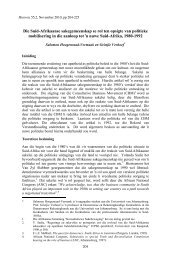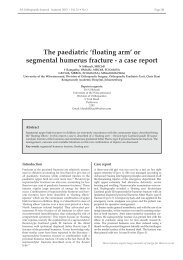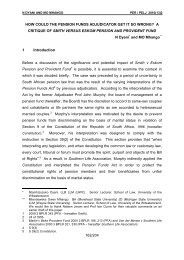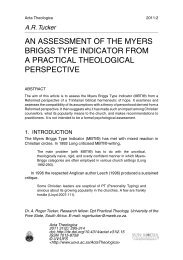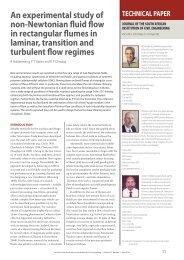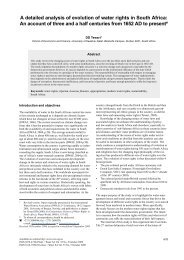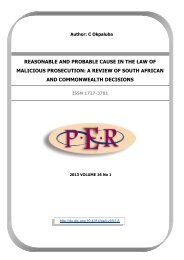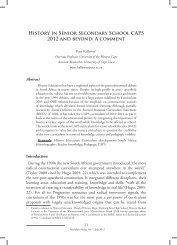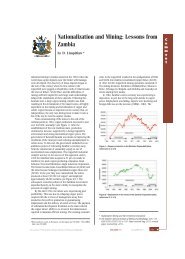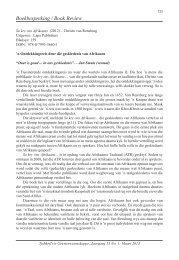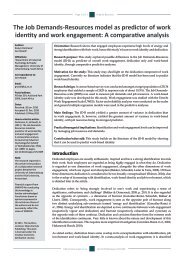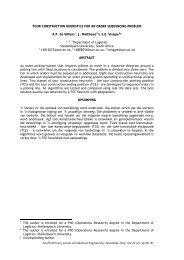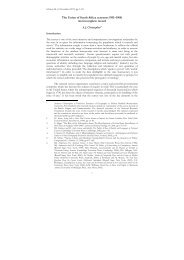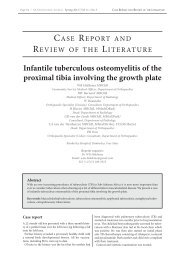91 Hendrik Verwoerd and the Leipzig School of Psychology in 1926 ...
91 Hendrik Verwoerd and the Leipzig School of Psychology in 1926 ...
91 Hendrik Verwoerd and the Leipzig School of Psychology in 1926 ...
You also want an ePaper? Increase the reach of your titles
YUMPU automatically turns print PDFs into web optimized ePapers that Google loves.
<strong>Hendrik</strong> <strong>Verwoerd</strong> <strong>and</strong> <strong>the</strong> <strong>Leipzig</strong> <strong>School</strong> <strong>of</strong> Pscyhology<br />
The approach <strong>of</strong> a developmental psychology expert like Volkelt is <strong>of</strong><br />
particular <strong>in</strong>terest because he compared stages <strong>in</strong> <strong>the</strong> cognitive<br />
development <strong>of</strong> children to those <strong>of</strong> whole civilisations. From <strong>the</strong> viewpo<strong>in</strong>t<br />
<strong>of</strong> child psychology, <strong>the</strong> fact that children’s draw<strong>in</strong>gs were <strong>in</strong>terpreted as an<br />
expression <strong>of</strong> <strong>the</strong> child’s perception ra<strong>the</strong>r than a copy <strong>of</strong> a given object was<br />
considered to be progress. Volkelt argued <strong>in</strong> favour <strong>of</strong> proceed<strong>in</strong>g <strong>in</strong> <strong>the</strong><br />
same way with “primitive peoples”, whose th<strong>in</strong>k<strong>in</strong>g on magic could not be<br />
properly understood by apply<strong>in</strong>g European st<strong>and</strong>ards: “Submission to s<strong>in</strong>gle<br />
traits, but not to that which is <strong>the</strong> essence <strong>of</strong> th<strong>in</strong>gs accord<strong>in</strong>g to our<br />
notions!” His explanation <strong>of</strong> primitive religion shows how he l<strong>in</strong>ked<br />
developmental psychology to ethnopsychology. Like Wundt, Volkelt was<br />
conv<strong>in</strong>ced that magical ideas were not <strong>the</strong> result <strong>of</strong> logical thought but ra<strong>the</strong>r<br />
a reaction <strong>of</strong> <strong>the</strong> affect to phenomena such as illness <strong>and</strong> death. 93<br />
Consequently, magical th<strong>in</strong>k<strong>in</strong>g was primarily an expression <strong>of</strong> <strong>in</strong>ner<br />
feel<strong>in</strong>gs. This sounds similar to <strong>the</strong> <strong>in</strong>terpretation <strong>of</strong> <strong>the</strong> children’s draw<strong>in</strong>gs<br />
by Lotte H<strong>of</strong>fmann <strong>in</strong> Volkelt’s course. The role <strong>of</strong> <strong>the</strong> affect was decisive<br />
because <strong>the</strong> “primitive” was unable to underst<strong>and</strong> certa<strong>in</strong> natural<br />
phenomena through <strong>the</strong> laws <strong>of</strong> causality. Volkelt referred to this as a “gap”<br />
<strong>in</strong> underst<strong>and</strong><strong>in</strong>g <strong>and</strong> noted elsewhere:<br />
The fact that such gaps exist is not due to some m<strong>in</strong>or development <strong>of</strong> a<br />
s<strong>in</strong>gle <strong>in</strong>tellectual function such as th<strong>in</strong>k<strong>in</strong>g. Ra<strong>the</strong>r it is <strong>the</strong> entire<br />
primitiveness, <strong>the</strong> state <strong>of</strong> <strong>the</strong> respective stage <strong>of</strong> development ... So we<br />
observe <strong>the</strong> gap although <strong>the</strong> faculties <strong>of</strong> th<strong>in</strong>k<strong>in</strong>g should allow <strong>the</strong> gap to be<br />
bridged ... but where <strong>the</strong> structure <strong>of</strong> consciousness, i.e. <strong>the</strong> comb<strong>in</strong>ations<br />
<strong>and</strong> <strong>the</strong> sequence <strong>of</strong> psychic events prevent it: <strong>the</strong>refore general lack <strong>of</strong><br />
structure [allgeme<strong>in</strong>e Ungeform<strong>the</strong>it]. 94<br />
Elsewhere <strong>in</strong> his notes he draws on magical th<strong>in</strong>k<strong>in</strong>g <strong>and</strong> causality:<br />
Not magical causality – but no causality at all. An animal moves towards an<br />
object with an <strong>in</strong>imical <strong>in</strong>tention, because it means to perceive an enemy ...<br />
As soon as it comes closer, it realises that <strong>the</strong> object is a piece <strong>of</strong> food <strong>and</strong><br />
not an enemy. Therefore it immediately starts to devour <strong>the</strong> food ... There is<br />
no change <strong>of</strong> object. Enemy – food – comes just one after <strong>the</strong> o<strong>the</strong>r ... This<br />
sequence at <strong>the</strong> same place is not at all a problem to <strong>the</strong> animal, because it<br />
doesn’t have <strong>the</strong> experience that would show that such a sequence actually<br />
doesn’t take place ... Now <strong>the</strong>re is “a” – <strong>the</strong>n “b” <strong>and</strong> at <strong>the</strong> same place. And<br />
“a” is different from “b” – experience <strong>of</strong> difference! – Yet where “b” comes<br />
from, although <strong>the</strong>re used to be “a”, is not questioned ... The affectation is a<br />
retard<strong>in</strong>g moment <strong>in</strong> development, which means <strong>the</strong> extension <strong>of</strong> logical<br />
categories over <strong>the</strong> whole range <strong>of</strong> objects ... The lack <strong>of</strong> shape <strong>of</strong> <strong>the</strong><br />
93. AWZGP, Volkelt Papers, Box 17, Art <strong>and</strong> Ethnopsychology, III, 1, Phenomenology<br />
<strong>of</strong> primitive naturalness <strong>and</strong> phenomenology <strong>of</strong> <strong>the</strong> gap; Various notes <strong>and</strong> papers<br />
(not pag<strong>in</strong>ated). On ano<strong>the</strong>r page <strong>in</strong> <strong>the</strong> same collection <strong>of</strong> notes he writes: “A<br />
factor necessary for thought on <strong>in</strong>dividual-causal happen<strong>in</strong>g, this factor can itself<br />
be a causal happen<strong>in</strong>g. But this lack<strong>in</strong>g factor <strong>in</strong> earlier stages is certa<strong>in</strong>ly not part<br />
<strong>of</strong> consciousness. In consciousness <strong>the</strong>re is only <strong>the</strong> feel<strong>in</strong>g that someth<strong>in</strong>g is<br />
lack<strong>in</strong>g.“ See also Box 23, with numerous notes on <strong>the</strong> “gap” <strong>and</strong> forms <strong>of</strong><br />
perception with <strong>the</strong> primitives, which is very different from “ours”. Translated from<br />
<strong>the</strong> orig<strong>in</strong>al German.<br />
94. AWZGP, Volkelt Papers, Box 17, <strong>Psychology</strong> <strong>of</strong> art <strong>and</strong> Ethnopsychology,<br />
unpag<strong>in</strong>ated, s<strong>in</strong>gle paper sheets. Translated from <strong>the</strong> orig<strong>in</strong>al German.<br />
114



